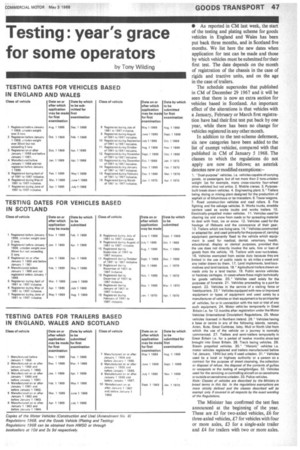Testing year's grace for some operators
Page 49

If you've noticed an error in this article please click here to report it so we can fix it.
by Tony Wilding • As reported in CM last week, the start of the testing and plating scheme for goods vehicles in England and Wales has been put back three months, and in Scotland five months. We list here the new dates when application for test can be made and those by which vehicles must be submitted for their first test. The date depends on the month of registration of the chassis in the case of rigids and tractive units, and on the age in the case of trailers.
The schedule supersedes that published in CM of December 29 1967 and it will be seen that there is now an extra section for vehicles based in Scotland. An important effect of the alterations is that vehicles with a January, February or March first registration have had their first test put back by one year, while there has been no change for vehicles registered in any other month.
In addition to the test-scheme deferment, six new categories have been added to the list of exempt vehicles, compared with that published in CM of January 5 1968. The classes to which the regulations do not apply are now as follows; an asterisk denotes new or modified exemptions:
1. "Dual-purpose" vehicles, i.e. vehicles capable of carrying goods, or passengers, but of not more than 2 tans unladen weight (as for example, many cross-country four-wheel drive vehiclesl but not attics. 2. Mobile cranes. 3. Purposebuilt break-down vehicles. 4. Engineering plant. 5. Trailers being drying or mixing plant designed for the production of asphalt or of bituminous or tar macadam. 6. Towerwagons, 7. Road construction vehicles and road rollers. 8. Fire fighting and fire salvage vehicles. 9. Works trucks, straddle carriers 'used as works trucks and works trailers. 10. Electrically-propelled motor vehicles. 11. Vehicles used for clearing ice and snow from roads or for spreading material to deal with frost, ice or snow. 12. Vehicles used for the haulage of lifeboats and the conveyance of their gear. 13. Trailers which are living vans. 14.' Vehicles constructed or adapted for, and used primarilyforthe purposeaf, carrying equipment permanently fixed to the vehicle which equipment is used for medical. dental, veterinary, health, educational, display or clerical purposes, provided that the use does not directly involve the sale, hire or loan of goods from the vehicle. 15. Trailers with over-run brakes. 16. Vehicles exempted from excise duty because they are limited in the use of public roads to six miles a week and any trailer drawn by them. 17. Land implements, land locomotives and land tractors. 18. ' Agricultural trailers drawn on roads only by a land tractor. /9. Public service vehicles or hackney carriages, in cases where these might technically be goods vehicles. 20.Vehicles used solely for the purposes of funerals. 21. Vehicles proceeding to a port for export. 22. Vehicles in the service of a visiting force or headquarters. 23. ' Vehicles equipped with new orimproved equipment or types of equipment and used solely by a manufacturer of vehicles or their equipmentorbyan importer of vehicles, for or in connection with the test or trial of any such equipment. 24. Motor vehicles temporarily in Great Britain i.e. for 12 months after registration under the Motor Vehicles (International Circulation) Regulations. 25. Motor vehicles licensed in Northern Ireland. 26. ' Vehicles having a base or centre In any of the following islands, namely, Arran, Bute. Great Cumbrae, Islay, Mull or North Uist from which the use of the vehicle on a journey is normally commenced. 27. Trailers and semi-trailers temporarily in Great Britain i.e. for a period of twelve months since last brought into Great Britain. 28. Truck laying vehicles. 29. Steam propelled vehicles. 30.. -Historicvehicles i.e. motor vehicles registered and trailers manufactured before lot January. 1940 but only if used unladen. 31. ' Vehicles used by a local or highway authority or a person on a contract for the purpose of street cleansing, the collection or disposal of refuse, the disposal of the contents of gullies or cesspools or the testing of weighbridges. 32. Vehicles used for the servicing or controlling aircraft on an aerodrome oroutside an aerodrome unladen. 33. Police vehicles.
Note: Classes of vehicles are described by the Ministry in broad terms in this list In the regulations exemptions are more strictly defined and the classes described will be exempt only if covered in all respects by the exact wording of the Regulations.
The Minister has confirmed the test fees announced at the beginning of the year. These are £5 for two-axled vehicles, £6 for three-axled vehicles, £7 for vehicles with four or more axles, £3 for a single-axle trailer and £.4 for trailers with two or more axles.




































































































































































































































